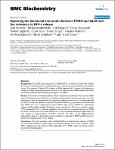Exploring the functional interaction between POSH and ALIX and the relevance to HIV-1 release
Votteler, Jörg
Iavnilovitch, Elena
Fingrut, Orit
Shemesh, Vivian
Taglicht, Daniel
Erez, Omri
Sörgel, Stefan
Walther, Torsten
Bannert, Norbert
Schubert, Ulrich
Reiss, Yuval
Background: The ALG2-interacting protein X (ALIX)/AIP1 is an adaptor protein with multiple functions in intracellular protein trafficking that plays a central role in the biogenesis of enveloped viruses. The ubiquitin E3-ligase POSH (plenty of SH3) augments HIV-1 egress by facilitating the transport of Gag to the cell membrane. Recently, it was reported, that POSH interacts with ALIX and thereby enhances ALIX mediated phenotypes in Drosophila. Results: In this study we identified ALIX as a POSH ubiquitination substrate in human cells: POSH induces the ubiquitination of ALIX that is modified on several lysine residues in vivo and in vitro. This ubiquitination does not destabilize ALIX, suggesting a regulatory function. As it is well established that ALIX rescues virus release of L-domain mutant HIV-1, HIV-1ΔPTAP, we demonstrated that wild type POSH, but not an ubiquitination inactive RING finger mutant (POSHV14A), substantially enhances ALIX-mediated release of infectious virions derived from HIV-1ΔPTAP L-domain mutant (YPXnL-dependent HIV-1). In further agreement with the idea of a cooperative function of POSH and ALIX, mutating the YPXnL-ALIX binding site in Gag completely abrogated augmentation of virus release by overexpression of POSH. However, the effect of the POSH-mediated ubiquitination appears to be auxiliary, but not necessary, as silencing of POSH by RNAi does not disturb ALIX-augmentation of virus release. Conclusion: Thus, the cumulative results identified ALIX as an ubiquitination substrate of POSH and indicate that POSH and ALIX cooperate to facilitate efficient virus release. However, while ALIX is obligatory for the release of YPXnL-dependent HIV-1, POSH, albeit rate-limiting, may be functionally interchangeable.
No license information
Related Items
Show related Items with similar Title, Author, Creator or Subject.
-
2007-05-25ZeitschriftenartikelFepA- and TonB-dependent bacteriophage H8: receptor binding and genomic sequence. Rabsch, Wolfgang; Ma, Li; Wiley, Graham; Najar, Fares Z.; Kaserer, Wallace; Schuerch, Daniel W.; Klebba, Joseph E.; Roe, Bruce A.; Gomez, Jenny A. Laverde; Schallmey, Marcus; Newton, Salete M. C.; Klebba, Phillip E.H8 is derived from a collection of Salmonella enterica serotype Enteritidis bacteriophage. Its morphology and genomic structure closely resemble those of bacteriophage T5 in the family Siphoviridae. H8 infected S. enterica ...
-
2013-08-08ZeitschriftenartikelCytomegalovirus Downregulates IRE1 to Repress the Unfolded Protein Response Stahl, Sebastian; Burkhart, Julia M.; Hinte, Florian; Tirosh, Boaz; Mohr, Hermine; Zahedi, René P.; Sickmann, Albert; Ruzsics, Zsolt; Budt, Matthias; Brune, WolframDuring viral infection, a massive demand for viral glycoproteins can overwhelm the capacity of the protein folding and quality control machinery, leading to an accumulation of unfolded proteins in the endoplasmic reticulum ...
-
2012-12-21ZeitschriftenartikelProtein-Protein Interaction Domains of Bacillus subtilis DivIVA Baarle, Suey van; Celik, Ilkay Nazli; Kaval, Karan Gautam; Bramkamp, Marc; Hamoen, Leendert W.; Halbedel, SvenDivIVA proteins are curvature-sensitive membrane binding proteins that recruit other proteins to the poles and the division septum. They consist of a conserved N-terminal lipid binding domain fused to a less conserved ...

